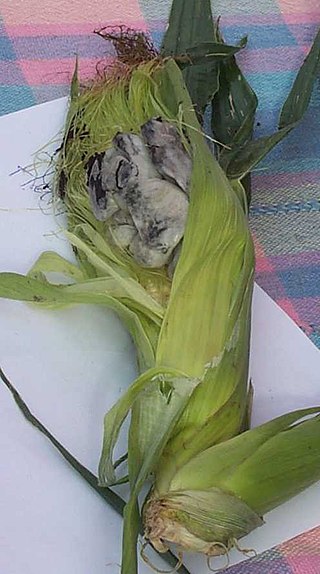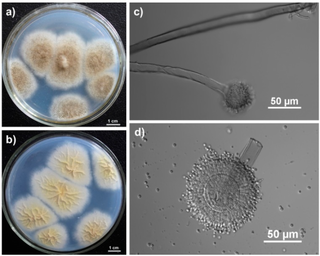
Aspergillus niger is a mold classified within the Nigri section of the Aspergillus genus. The Aspergillus genus consists of common molds found throughout the environment within soil and water, on vegetation, in fecal matter, on decomposing matter, and suspended in the air. Species within this genus often grow quickly and can sporulate within a few days of germination. A combination of characteristics unique to A. niger makes the microbe invaluable to the production of many acids, proteins and bioactive compounds. Characteristics including extensive metabolic diversity, high production yield, secretion capability, and the ability to conduct post-translational modifications are responsible for A. niger's robust production of secondary metabolites. A. niger's capability to withstand extremely acidic conditions makes it especially important to the industrial production of citric acid.

Aspergillus fumigatus is a species of fungus in the genus Aspergillus, and is one of the most common Aspergillus species to cause disease in individuals with an immunodeficiency.

A heterokaryon is a multinucleate cell that contains genetically different nuclei. Heterokaryotic and heterokaryosis are derived terms. This is a special type of syncytium. This can occur naturally, such as in the mycelium of fungi during sexual reproduction, or artificially as formed by the experimental fusion of two genetically different cells, as e.g., in hybridoma technology.

Aspergillus is a genus consisting of several hundred mould species found in various climates worldwide.

Aspergillus oryzae, also known as kōji mold, is a filamentous fungus used in East Asia to saccharify rice, sweet potato, and barley in the making of alcoholic beverages such as sake and shōchū, and also to ferment soybeans for making soy sauce and miso. However, in the production of fermented foods of soybeans such as soy sauce and miso, Aspergillus sojae is sometimes used instead of A. oryzae. Incidentally, in China and Korea, the fungi used for fermented foods for a long time in the production of traditional alcoholic beverages were not A. oryzae but fungi belonging to Rhizopus and Mucor. A. oryzae is also used for the production of rice vinegars. Barley kōji (麦麹) or rice kōji (米麹) are made by fermenting the grains with A. oryzae hyphae.
Pathogenic fungi are fungi that cause disease in humans or other organisms. Although fungi are eukaryotic, many pathogenic fungi are microorganisms. Approximately 300 fungi are known to be pathogenic to humans; their study is called "medical mycology". Fungal infections kill more people than either tuberculosis or malaria—about 2 million people per year.

A fungus is any member of the group of eukaryotic organisms that includes microorganisms such as yeasts and molds, as well as the more familiar mushrooms. These organisms are classified as one of the traditional eukaryotic kingdoms, along with Animalia, Plantae and either Protista or Protozoa and Chromista.

The Ustilaginaceae are a family of smut fungi in the order Ustilaginomycetes. Collectively, the family contains 17 genera and 607 species.

Marine fungi are species of fungi that live in marine or estuarine environments. They are not a taxonomic group, but share a common habitat. Obligate marine fungi grow exclusively in the marine habitat while wholly or sporadically submerged in sea water. Facultative marine fungi normally occupy terrestrial or freshwater habitats, but are capable of living or even sporulating in a marine habitat. About 444 species of marine fungi have been described, including seven genera and ten species of basidiomycetes, and 177 genera and 360 species of ascomycetes. The remainder of the marine fungi are chytrids and mitosporic or asexual fungi. Many species of marine fungi are known only from spores and it is likely a large number of species have yet to be discovered. In fact, it is thought that less than 1% of all marine fungal species have been described, due to difficulty in targeting marine fungal DNA and difficulties that arise in attempting to grow cultures of marine fungi. It is impracticable to culture many of these fungi, but their nature can be investigated by examining seawater samples and undertaking rDNA analysis of the fungal material found.

Penicillium rubens is a species of fungus in the genus Penicillium and was the first species known to produce the antibiotic penicillin. It was first described by Philibert Melchior Joseph Ehi Biourge in 1923. For the discovery of penicillin from this species Alexander Fleming shared the Nobel Prize in Physiology or Medicine in 1945. The original penicillin-producing type has been variously identified as Penicillium rubrum, P. notatum, and P. chrysogenum among others, but genomic comparison and phylogenetic analysis in 2011 resolved that it is P. rubens. It is the best source of penicillins and produces benzylpenicillin (G), phenoxymethylpenicillin (V) and octanoylpenicillin (K). It also produces other important bioactive compounds such as andrastin, chrysogine, fungisporin, roquefortine, and sorbicillins.

Human interactions with fungi include both beneficial uses, whether practical or symbolic, and harmful interactions such as when fungi damage crops, timber, food, or are pathogenic to animals.

Aspergillus tubingensis is a darkly pigmented species of fungus in the genus Aspergillus section Nigri. It is often confused with Aspergillus niger due to their similar morphology and habitat. A. tubingensis is often involved in food spoilage of fruits and wheat, and industrial fermentation. This species is a rare agent of opportunistic infection.

Velvet complex is a group of proteins found in fungi and especially molds that are important in reproduction and production of secondary metabolites including penicillin. The core members of the complex include VeA, LaeA, and VelB. Other proteins including VelC and VosA sometimes function in the complex. The proteins were first characterized in Aspergillus nidulans.
Aspergillus luchuensis is a species of fungus in the genus Aspergillus. It belongs to the group of black Aspergilli which are important industrial workhorses. The fungus has been used to make awamori, a distilled spirit in Okinawa Island, Japan, and is also used to make shōchū and sake. This species was first isolated and described by Tamaki Inui of the University of Tokyo in 1901. For more than 100 years there has been confusion between this species and Aspergillus awamori and Aspergillus niger with regard to scientific names and classification.
Aspergillus giganteus is a species of fungus in the genus Aspergillus that grows as a mold. It was first described in 1901 by Wehmer, and is one of six Aspergillus species from the Clavati section of the subgenus Fumigati. Its closest taxonomic relatives are Aspergillus rhizopodus and Aspergillus longivescia.
Aspergillus viridinutans is a species of fungus in the genus Aspergillus. The species was first isolated in Frankston, Victoria, Australia and described in 1954. It is from the Fumigati section of Aspergillus. Several fungi from this section produce heat-resistant ascospores, and the isolates from this section are frequently obtained from locations where natural fires have previously occurred. A. viridinutans has been identified as the cause of chronic aspergillosis. The mycotoxin viriditoxin was first identified in A. viridinutans. A draft genome sequence of the strain derived from the original species description has been generated.

Mushrooms have been found in art traditions around the world, including in western and non-western works. Ranging throughout those cultures, works of art that depict mushrooms can be found in ancient and contemporary times. Often, symbolic associations can also be given to the mushrooms depicted in the works of art. For instance, in Mayan culture, mushroom stones have been found that depict faces in a dreamlike or trance-like expression, which could signify the importance of mushrooms giving hallucinations or trances. Another example of mushrooms in Mayan culture deals with their codices, some of which might have depicted hallucinogenic mushrooms. Other examples of mushroom usage in art from various cultures include the Pegtymel petroglyphs of Russia and Japanese Netsuke figurines.
Cytochrome P450, family 53, also known as CYP53, is a cytochrome P450 monooxygenase family in fungi related to hydrocarbon assimilation. They are distributed in both Ascomycota and Basidiomycota, could be used as anti-fungal drug target. The first gene identified in this family is the CYP53A1 from Aspergillus niger encoding the Benzoate 4-monooxygenase (bphA).

Mucoromycota is a division within the kingdom fungi. It includes a diverse group of various molds, including the common bread molds Mucor and Rhizopus. It is a sister phylum to Dikarya.

Fungi are a common theme or working material in art. They appear in many different artworks around the world, starting as early as around 8000 BCE. Fungi appear in nearly all art forms, including literature, paintings, and graphic arts; and more recently, contemporary art, music, photography, comic books, sculptures, video games, dance, cuisine, architecture, fashion, and design. There are a few exhibitions dedicated to fungi, and even an entire museum.














